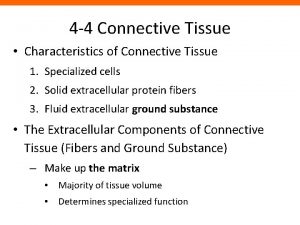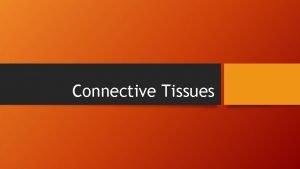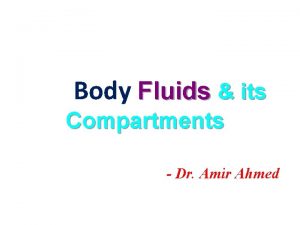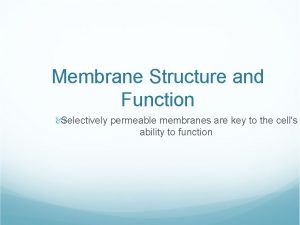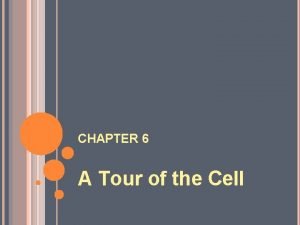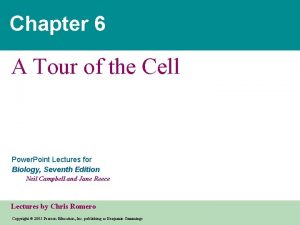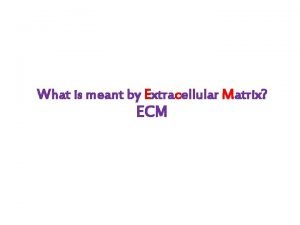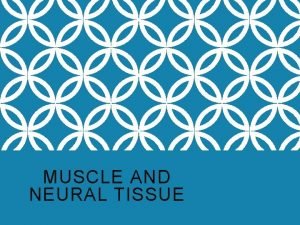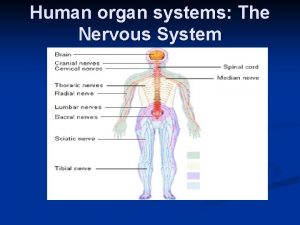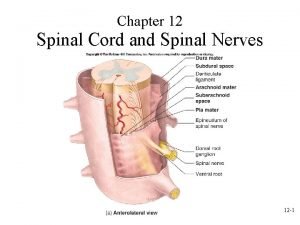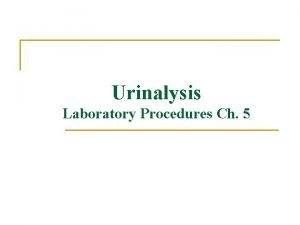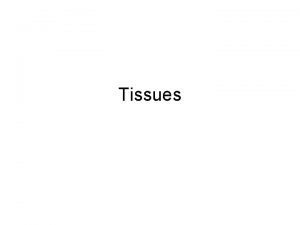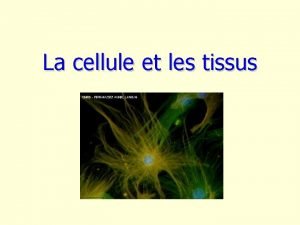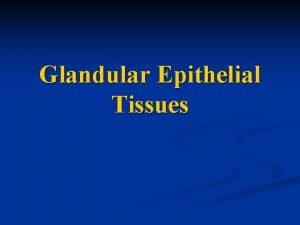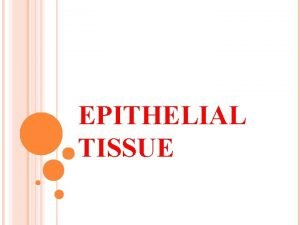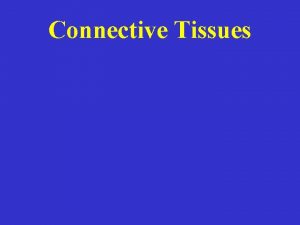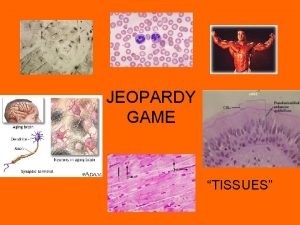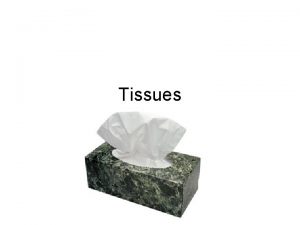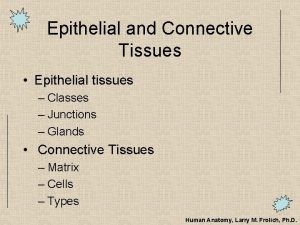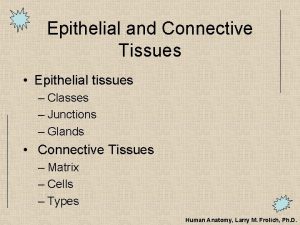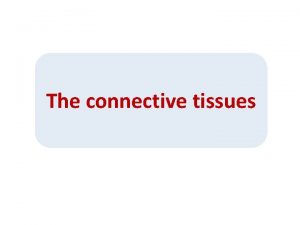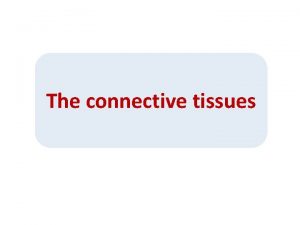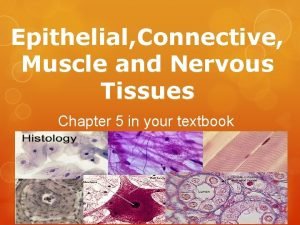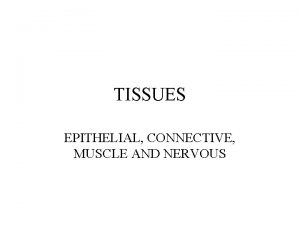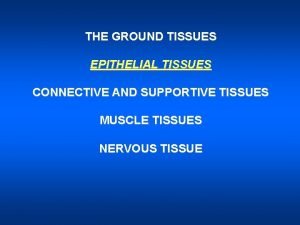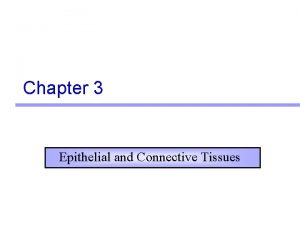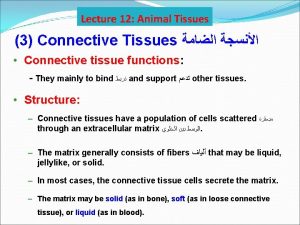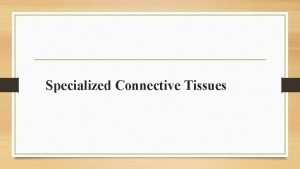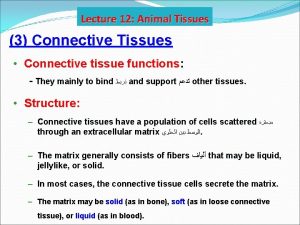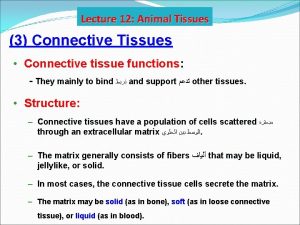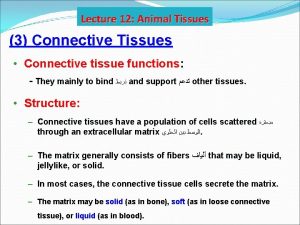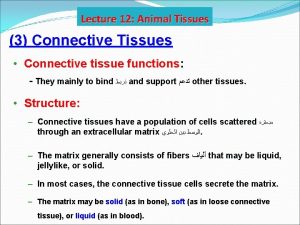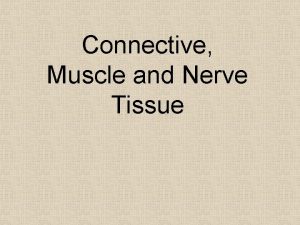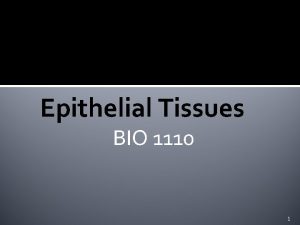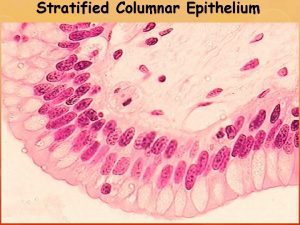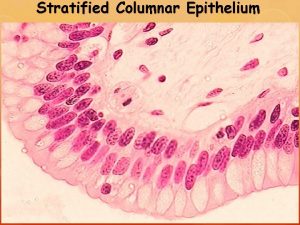Unit 2 Tissues Epithelial Connective Muscle Nervous INTERCELLULAR


































- Slides: 34

Unit 2: Tissues Epithelial Connective Muscle Nervous

INTERCELLULAR JUNCTIONS How cells connect to make tissues Tight junctions prevent fluid from moving across a layer of cells 0. 5 µm Tight junction Intermediate filaments Desmosome Gap junctions Space between cells Plasma membranes of adjacent cells Desmosome 1 µm Extracellular matrix Gap junction 0. 1 µm

• At tight junctions, membranes of neighboring cells are pressed together, preventing leakage of extracellular fluid • Desmosomes (anchoring junctions) fasten cells together into strong sheets • Gap junctions (communicating junctions) provide cytoplasmic channels between adjacent cells • Hemidesmosomes anchors the cell to a substrate Desmosome Hemidesmosome

Intercellular Junctions : connect adjacent cell membranes to form tissues Gap Junctions (allow ions to pass between cells for communication) Gap junctions are one type of cell connection. When two cells are right next to each other, their cell membranes may actually be touching. A gap junction is an opening from one cell to another. It's not a big opening, but it is large enough for cytoplasm/ions to move from one cell to another. Organelles cannot move between cells (too large). The connections are called channels and they act like tunnels for the movement of molecules. They may open/close. Located in cardiac tissue (heart). Desmosomes are a second type of cell connection. They physically connect cells like the gap junction, but no opening is created. Proteins that bond the membrane of one cell to its neighbor create the desmosomes. You will find desmosomes in your skin cells. All of those proteins hold your skin together. The distance between the cells, however small, is about 10 times wider than the gap junction connections. Located in outer skin. Tight Junction (prevent movement of substances between cells) The last type of connection we will introduce is the tight junction. Tight junctions happen when two membranes actually bond into one. It makes a very strong barrier between two cells. Cells have some distance with a desmosome. Gap junctions allow molecules to pass. Tight junctions form solid walls. These types of connections are often found where one area needs to be protected from the contents of other areas. Prevent movement of substances between cells. Located in small intestine.

PROJECT Create a model for each type of junction: 1) tight junction, 2) gap junction, 3) desmosome, 4) hemidesmosome. You may work in groups of 4, each creating one of the models. Make sure you all agree on the model, as you are responsible for each of them. Supplies such as clay, pipe cleaners, straws, Saran Wrap, cardboard, wire are useful! Food items should be avoided as they do not hold up well, nor last very long.

Tissue Types: epithelial, connective, muscle, nervous Epithelium General characteristics • cover organs (serous membranes) and the body (cutaneous membranes) • line body cavities (serous membranes) • line hollow organs (mucous membrane) • have a free surface (apical) • have a basement membrane (basal lamina) (attaches to underlying tissue) • avascular (no blood vessels) • cells readily divide (at basement • membrane) cells tightly packed (little intercellular space) Lumen(Inner cavity of tubule) • cells often have desmosomes • classified according to the number of cell layers and cell shape Simple = single layer Stratified = more than 1 layer Pseudostratified = 1 layer, all cells attached to basement membrane, but not all cells reach free surface, nuclei at different levels Squamous = flat Cuboidal = cube Columnar = rectangle

Use the Epithelial Tissue Types Chart to take notes on tissue types that follow.

Epithelial Tissues Simple squamous – • single layer of flat cells • substances pass easily through • line air sacs (alveoli in lungs) • line blood vessels • line lymphatic vessels • filtration, diffusion, osmosis

Epithelial Tissues Simple cuboidal – • single layer of cube-shaped cells • line kidney tubules • cover ovaries • line ducts of some glands • secretion, absorption

Epithelial Tissues Simple columnar – • single layer of elongated/rectangular cells • sometimes possess cilia (move secretions along surface (NOT for FILTRAT • sometimes possess microvilli (increases surface area to increase absorption • often have goblet cells (produce mucus) • line uterus, stomach, intestines • protection, secretion, absorption

Epithelial Tissues Pseudostratified columnar – • single layer of elongated/rectangular cells • all cells are attached to the basement membrane • not all cells reach the free surface • nuclei are at different levels • often have cilia (propel secretions along the surface—NOT FOR FILTRATION!) • often have goblet cells (produce mucus) • line respiratory passageways • protection, secretion, movement of mucus & substances

Epithelial Tissues Stratified squamous – • many cell layers • top cells are flat • can accumulate keratin (then tissue is called keratinized stratified sqaumous, outer layer of cells are dead, provides waterproofing and tough exterior where abrasions are common) • outer layer of skin • line oral cavity, throat, vagina, and anal canal • protection

Epithelial Tissues Stratified cuboidal – • 2 -3 layers • cube-shaped cells • line ducts of mammary glands, sweat glands, salivary glands, and the pancreas • protection, some secretion/absorption

Epithelial Tissues Stratified columnar – • top layer of elongated cells • cube-shaped cells in deeper layers (basal layer…at basement membrane) • line vas deferens, male urethra, and part of pharynx • protection, secretion

Epithelial Tissues Transitional – • many cell layers • cube-shaped and elongated cells • line urinary bladder, ureters, and part of urethra • distensibility (stretching), protection

Check out this site to review epithelial tissue types (click on it): http: //www. mhhe. com/biosci/ap/histology_mh/tismodov. html#overview

Glandular Epithelium: Exocrine (ducts) & Endocrine (ductless) Composed of cells that are specialized to produce and secrete substances Exocrine glands have ducts Unicellular exocrine gland • composed of one cell • goblet cell (produce mucus) Structural Types of Exocrine Glands Multicellular exocrine gland • composed of many cells • sweat glands, salivary glands, etc.

Types of Exocrine Glandular Secretions Merocrine glands Apocrine glands • fluid product • salivary glands • pancreas • sweat glands • cells secrete their product through exocytosis and remain Holocrine glands • cellular product (secretion) • portions of cells • mammary glands (milk) • ceruminous glands (earwax) • part of the secreting cell • secretory products • whole cells • sebaceous glands (oil) • cells accumulate secretory product in their cytosol (cytoplasm), die, and are discharged with their contents

Endocrine glands are ductless Secretions made directly into Endocrine glands release hormones (chemical bloodstream messengers) into the bloodstream to be transported to various organs and tissues throughout the body. For instance, the pancreas secretes insulin, which allows the body to regulate levels of sugar in the blood. The thyroid gets instructions from the pituitary to secrete hormones which determine the pace of chemical activity in the body (the more hormone in the bloodstream, the faster the chemical activity; the less hormone, the slower the activity).

EXOCRINE Glands Secrete into external environment ENDOCRINE Glands Secrete into internal environment Ducts-secrete onto a surface by way of holocrine, Ductless- secrete directly apocrine or merocrine secretion methods. Describe each into the bloodstream method in the space below. Secretes sweat, oil, wax, enzymes, etc. Secrete HORMONES ~Goblet Cells (unicellular) ~Sweat glands, salivary glands, pancreas (multicellular) ~6 Structural types: List/describe/draw below. Additional sheet may be used. Pancreas, thyroid, parathyroid, adrenal, pituitary, testes, ovaries

Types of Epithelial Membranes Serous • line body cavities that lack openings outside • reduce friction • inner lining of thorax and abdomen • cover organs of thorax and abdomen • secrete serous fluid (pleural and pericardial) • visceral and parietal • pericardium, pleura, peritoneum • line tubes and organs that open to outside world • lining of mouth, nose, throat, etc. • secrete mucus Mucous Cutaneous • covers body • skin to

Connective Tissues (CT) General characteristics • most abundant tissue type • many functions • bind structures • provide support and protection • serve as frameworks • fill spaces • store fat • produce blood cells • protect against infections • help repair tissue damage • Made of cells, fibers, and a ground substance (all vary with the type of CT) • have a matrix (made of ground substance and fibers)- fills spaces between cell functions as a “sieve” where nutrients and gases may diffuse • have varying degrees of vascularity (cartilage= avascular, bone= rich blood supply) • have cells that usually divide

The matrix of connective tissue typically consists of fibers and a featureless ground substance. The most abundant fiber in connective tissues is a tough protein called collagen. Tendons, ligaments, and the white stringy tissue (fascia) seen in some cuts of meat are composed almost entirely of collagen, as is leather, which consists of the connective tissue layer (dermis) of animal skins. Collagen also strengthens bone and cartilage. Elastic and reticular fibers are less abundant connective tissue proteins with a more limited distribution. The ground substance may be liquid, as in blood; gelatinous, as in areolar tissue; rubbery, as in cartilage; or calcified and stony, as in bone. It consists mainly of water and small dissolved ions and organic molecules, but the gelatinous to rubbery consistency of some tissues results from enormous proteincarbohydrate complexes in the ground substance. The hard consistency of bone results mainly from calcium phosphate salts in the ground substance.

Connective Tissue: Major Cell Types Fibroblasts -fixed cell -most common cell -large, starshaped -produce fibers Plasma cell -wandering cell -produce immunoglobins (antibodies) Fat cell -fixed cell -fat storage Mast cells -fixed cell -release heparin (anticoagulant ) -release histamine (inflammation) -release serotonin Macrophages (vasoconstrictio -wandering cell n) -phagocytic -important in

Connective Tissue: Major Fiber Types Collagenous fibers • thick, stains pink • composed of collagen (protein) • great tensile strength/not elastic • abundant in dense CT • hold structures together • tendons, ligaments Elastic fibers • bundles of protein elastin • stains purple • fibers branch • elastic, rubbery resilience • vocal cords, air passages, skin, lungs, blood vessels Reticular fibers • very thin/fine collagenous fibers • highly branched, stains purple • form supportive networks

Connective Tissues Connective tissue proper Specialized connective tissue • loose (areolar) connective tissue • cartilage • adipose tissue hyaline • reticular connective tissue elastic • dense connective tissue fibrocartilage Supporting CT • elastic connective tissue • bone • blood Fluid CT

Connective Tissues Loose connective tissue • mainly fibroblasts • fluid to gel-like matrix • collagenous fibers • elastic fibers • bind skin to structures • beneath most epithelia • between muscles Adipose tissue • adipocytes • cushions • insulates • store fats • beneath skin • behind eyes • around kidneys and heart

Connective Tissues Reticular connective tissue • composed of reticular fibers • supports • walls of liver, spleen, lymphatic organs Dense connective tissue • packed collagenous fibers • elastic fibers • few fibroblasts • bind body parts together • tendons, ligaments, dermis • poor blood supply

Connective Tissues Elastic connective tissue • abundant in elastic fibers • some collagenous fibers • fibroblasts • attachments between vertebrae • walls of large arteries, airways, heart Bone • solid matrix • supports • protects • forms blood cells • attachment for muscles • skeleton • osteocytes in lacunae

Connective Tissues Hyaline cartilage Cartilage • most abundant • ends of bones • nose, respiratory passages • embryonic skeleton • rigid matrix • chondrocytes in lacunae • poor blood supply Elastic cartilage • flexible • three types • external ear, larynx • hyaline • elastic Fibrocartilage • fibrocartilage • very tough • shock absorber • intervertebral discs • pads of knee and pelvic girdle

Connective Tissues Three types of cartilage Hyaline cartilage Elastic cartilage Fibrocartilage

Connective Tissues Blood • fluid matrix called plasma • red blood cells • white blood cells • platelets • transports • defends • clotting • throughout body in blood vessels • heart

Muscle Tissues General characteristics • muscle cells called muscle fibers • contractile • three types • skeletal • smooth • cardiac Skeletal muscle • attached to bones • striated, voluntary Smooth muscle • walls of organs, skin, walls of blood vessels • involuntary, not striated Cardiac muscle • heart wall • involuntary, striated, intercalated discs

Nervous Tissues • found in brain, spinal cord, and peripheral nerves • basic cells are neurons • neuroglial cells are supporting cells • sensory reception • conduction of nerve impulses
 Body tissues chapter 3 cells and tissues
Body tissues chapter 3 cells and tissues 4 body tissues
4 body tissues Body tissues chapter 3 cells and tissues
Body tissues chapter 3 cells and tissues Eisonophil
Eisonophil Body tissues chapter 3 cells and tissues
Body tissues chapter 3 cells and tissues Special connective tissue
Special connective tissue Characteristics connective tissue
Characteristics connective tissue Loose connective tissue cell types
Loose connective tissue cell types What do all connective tissues have in common
What do all connective tissues have in common Difference between intercellular and intracellular fluid
Difference between intercellular and intracellular fluid Intercellular connections
Intercellular connections Muscular tissue
Muscular tissue Chloroplast function
Chloroplast function Chapter 6 a tour of the cell answers
Chapter 6 a tour of the cell answers Intercellular connections
Intercellular connections Extracellular
Extracellular Neuronal pool
Neuronal pool Nervous
Nervous Processes of neuron
Processes of neuron Autonomic nervous system pathway
Autonomic nervous system pathway What are the characteristics of nervous tissue
What are the characteristics of nervous tissue Different types of muscle cells
Different types of muscle cells _____ muscles run across the cheek.
_____ muscles run across the cheek. Basic unit of nervous system
Basic unit of nervous system Blood clot feedback loop
Blood clot feedback loop Functional unit of nervous system
Functional unit of nervous system Unit 6 review questions
Unit 6 review questions Urine cast
Urine cast Layers of epithelial tissue
Layers of epithelial tissue Simple cuboidal epithelium tissue function
Simple cuboidal epithelium tissue function Epithelial dysplasia
Epithelial dysplasia Viscoelastic theory of pdl
Viscoelastic theory of pdl Schema tissu epithelial
Schema tissu epithelial Epitelio glandular holocrino
Epitelio glandular holocrino Tecido
Tecido






